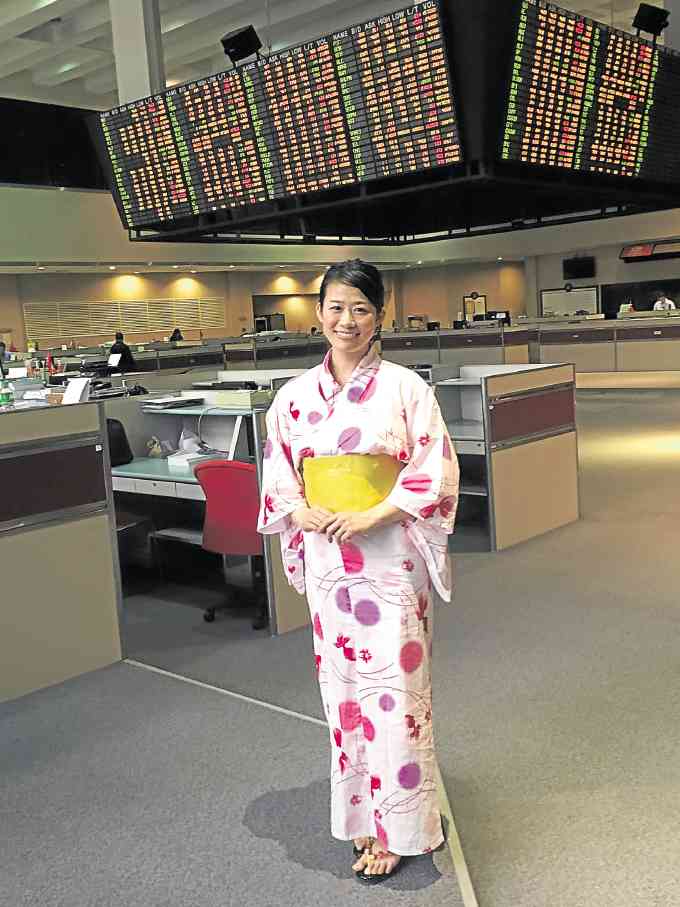A pretty young woman in pink kimono sashayed into the Tektite trading floor of the Philippine Stock Exchange. She is Emi Ogura, a commercial model from Okayama prefecture in Japan, who was visiting the country for the first time.
She was with a tour group of about a dozen other Japanese tourists. But this was no ordinary tour group. Instead of going to the quintessential sightseeing spots in the metropolis like the Walled City of Intramuros or the Rizal Park, they went to the PSE to learn about how the local exchange was operating. They also visited the offices of conglomerate San Miguel Corp. and homegrown fast-food giant Jollibee Foods Corp. They were also scheduled to go to the integrated gaming resorts at Pagcor City.
Ogura and her peers in the tour group are investors in the Philippine Stock Exchange. In the case of Ogura, she started investing two months before she visited the PSE on Feb. 10 and was very happy with the results.
Veteran stock broker Joseph Roxas, president of Eagle Equities Inc. with whom the group opened stock trading accounts, was there to welcome the Japanese delegation and brief them about the local course.
Eagle Equities uncovered the potential of the Japanese retail investor market in partnership with Japanese run-property brokerage house Seven Seas Properties Corp. While offering condominium units in the Philippines to the Japanese market, Seven Seas saw a number of clients interested not just in condominium units but also in stocks and infrastructure in the Philippines. Those interested in investing in stocks are referred to Eagle Equities, which will send representatives to Japan to conduct Philippine stock investing seminars whenever needed.
It’s a niche market that shows a lot of promise. A typical Japanese retail investor will allot P500,000 to build a Philippine portfolio compared to an average of only P100,000 among start-up Filipino investors.
For many of the Japanese retail investors trying out the local stock market, it’s all about finding better yields and taking advantage of the Philippines’ upward trajectory. The country has emerged to be one of Asia’s fastest growing economies in recent years.
In the case of Ogura, her Philippine portfolio made a 25-percent return in two months after she started investing. She picked up stocks like Agrinurture Inc. and gaming operator Melco Crown (Philippines).
“Thank you Philippines,” Ogura said.
“The current situation in the Philippines looks like Japan in the 1980s when the economy expanded rapidly,” Ogura said in an interview, through a Japanese interpreter. “Compared to Japan, you already have IT (information technology industry) and Filipinos can speak English.
She said 30 percent of her investment portfolio was in stocks. Apart from a global equity-laced fund, she said she was investing only in the Philippines.
Thus she had to come to the Philippines to see for herself and the visit reaffirmed her conviction. “The Philippines’ image has changed. It’s very energetic,” he said.
This Japanese lady said reading the charts helped her choose her investments.
Uno Yoshiniro, a man who hails from the same prefecture as Ogura, had been investing in stocks in the last 10 years. His portfolio is mostly invested in Japan and had started to invest in the Philippines a month before visiting the PSE.
Yoshiniro said his Philippine portfolio made a return of about 20 percent in just one month. He had invested in San Miguel Corp., Bloomberry Resorts Corp., DoubleDragon Properties Corp., EEI Corp., Metro Pacific Investments and Megawide Construction Corp.
He’s so happy that he’s considering to transfer all of his equities investments—which account for 40 percent of his total investment portfolio—to the Philippines.
Every year, the PSE holds investor roadshows in Japan in partnership with DBP-Daiwa Capital Markets Philippines. The roadshows showcase top Philippine corporations and are mainly focused on institutional investors. By personally meeting with fund managers, the PSE and the listed companies encourage them to invest or further increase their exposure in the local market.
Tapping the Japanese retail market is seen complementing overall efforts to broaden investor participation in the local market.
